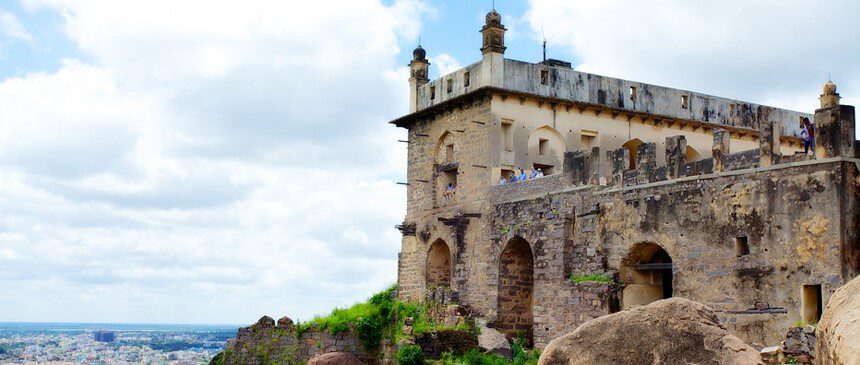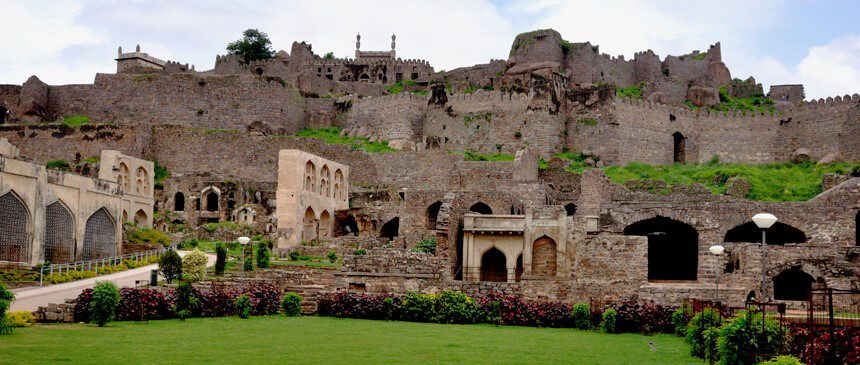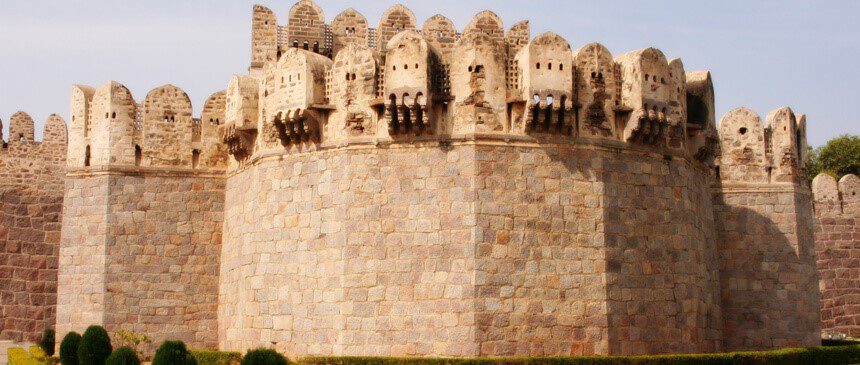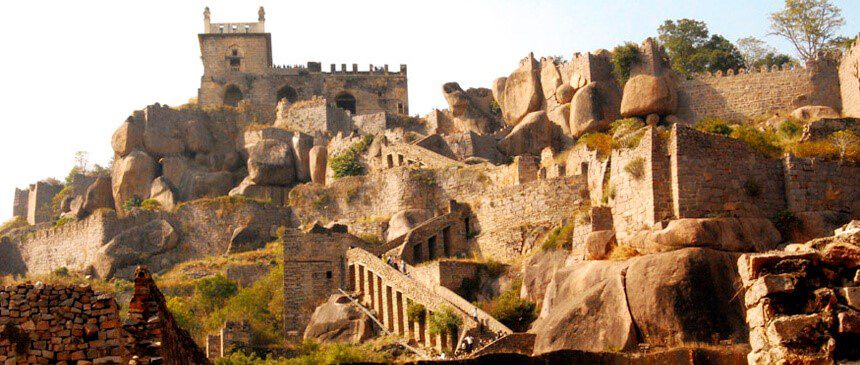Believe it or not but Hyderabad’s Golconda Fort is worth Rs 15,200 crore or $2 billion and this is considering just the cost of land. Located in the western part of Hyderabad city, Golconda Fort owes its present grandeur to Mohammad Quli Qutub Shah, who took over the Golconda Fort from the Bahmani dynasty. A historical marvel known for its size and location, Golconda is often listed as one of the most magnificent fortresses in India. Golconda’s interiors, architecture and planning make it one of the must-visit places in India as the history associated with it is nothing short of exceptional.
Here’s everything you should know about Hyderabad’s Golconda Fort, its valuation and its historical importance.
How to reach Golconda Fort?
By Air: The nearest airport is Hyderabad’s Rajiv Gandhi International Airport at a distance of 26.7 km from the fort.
By Train: The nearest railway station is Hyderabad Deccan Railway Station at a distance of 10.7 km from the fort.
By Road: The city has an efficient local transportation system connecting its different areas, ensuring convenient travel. The Fort is located approximately 9 km from Hussain Sagar Lake and can be easily reached by car, bus, or auto-rickshaw, all of which operate within the city.
Best time to visit Golconda Fort
The optimal period to explore Hyderabad is from September to March, when the weather is mild and pleasant. Visiting Golconda Fort during the evening hours is recommended, as the climate is delightful, and you can also enjoy a captivating sound and light show.
Golconda Fort: Timings and entry fee
Golconda Fort stays open to visitors from 9 AM to 5 PM every day of the week. The entry fee for the for is:
The entry fees for the fort is as follows:
- Indian visitors: Rs 5
- Foreign tourists: Rs 100
- Entry with a still camera: Rs 25
- Ticket for sound and light show: Rs 130
Golconda Fort: History and construction
Golconda, built in the 12th century, was originally a mud fort but was fortified later by the Bahmani Sultans between the 14th and 17th centuries. The fort later changed hands and the Qutub Shahi dynasty made it the capital of their kingdom.

Source: Telangana Tourism official website
The inner fort still has ruins of palaces, mosques and a hilltop pavilion which rises about 130 metres high and gives a bird’s eye view of the other buildings.

Source: Telangana Tourism official website
Golconda in Telugu means ‘shepherd’s hill’, meaning Golla Konda, which according to local legend was about a boy who came across an idol here. The Kakatiya king then constructed a mud fort here, which was later taken over by the Bahamani kings.

Source: Telangana Tourism official website
See also: All about the Agra Fort
The structure that you see today is built by the Qutub Shahi kings as they converted the mud fort into a massive granite fort extending 5 kms in circumference. It was in 1687 when Mughal emperor Aurangzeb took over the Golconda and left it in ruins.
The fort still has mounted cannons, drawbridges, gateways and majestic halls. The fort is also an engineering marvel as it has a number of acoustical features. For example, a person talking at the dome entrance can be clearly heard from the hilltop pavilion, which is almost one kilometre away.

Source: Telangana Tourism official website

Source: Telangana Tourism official website
See also: Top localities to invest in Hyderabad
Golconda Fort: Folklore
According to local folklore, Golconda used to be a famous diamond market, which used to attract merchants from across the world. In fact, the famous Koh-i-noor and Hope diamonds were stored here.

Source: Instagram

Source: Instagram
It is believed that there is a secret underground tunnel that connects the main ‘durbar hall’ and the one of the palace gates at the foot of the hill. Other folk tales also suggest that there is a secret tunnel to the Charminar.
The Naya Qila is the extension of Golconda Fort and has a residential area with many towers and a mosque.
There is a mining town in Arizona, US, which is named after Golconda, because it had mines like the ones found here, near the fort. There are two other towns in the US which were renamed to Golconda, because of the mines. Both of these are now ghost towns.
Check out properties for sale in Hyderabad
Golconda Fort : Valuation
While the values of heritage buildings are beyond comprehension, here is a rough estimate of how much Golconda Fort Hyderabad is worth:
The per sq ft price in Golconda Fort area is Rs 4,718.
Total area of Golconda Fort: 3 sq kms
Total land cost of Golconda Fort: Rs 152 billion, approximately which translates into $2-billion, considering the current exchange rate.
This cost does not include the construction costs or any other premium which is usually attached with heritage structures.
| The value of great buildings is a matter of great curiosity and interest to us. In our day-to-day lives, however, we may need to know the valuation of properties, for the purpose of sale, rent, etc. To find out the value of the property you are interested in, check out Housing.com’s Property valuation calculator. |
Golconda Fort and popular diamonds
The Kohinoor diamond, renowned as the world’s most famous and one of the largest diamonds ever mined, holds a significant place in history. Discovered in Golconda, South India, around 1650 by Golconda ruler Asif Jah I, this magnificent gem has captivated the world with its beauty and storied past. The Hope Diamond, also known as the Matar Mahal (The Palace of Mirrors), shares a similar origin, hailing from Golkonda and measuring an impressive 31.52 cm x 21 cm x 6 cm, with a weight of 2,106 carats.
The Daria-i-Noor, another notable diamond, witnessed a surge in value when Henry III gifted it back to France after successfully defeating Sultan Muzaffar Shah II during his invasion of India in 1531 AD. This historical event added to the allure of the Daria-i-Noor, making it a gem of great cultural and historical significance.
FAQs
What is Golconda Fort famous for?
Golconda is known for diamond mines situated near the fort. In the ancient times, India had the only known diamond mines in the world.
Who built Golconda fort?
The Kakatiya dynasty built the mud fort in the 13th century, which was later transformed into a granite fort by Qutub Shah’s dynasty.
Where is Golconda fort located?
Golconda fort is located in Hyderabad.
What is the story of Golkonda fort?
The Golconda fort was originally constructed by the Kakatiya dynasty to safeguard the western region of their kingdom. It was built atop a granite hill and later fortified by Rani Rudrama Devi and her successor Prataparudra. Subsequently, the Musunuri dynasty gained control of the fort after defeating the Tughlaqi army.
Who destroyed Golconda fort?
In 1687, the Golconda Fort met its ultimate demise at the hands of the Mughal ruler, Aurangzeb.
Who was jailed in Golconda Fort?
Inside the fort lies a small prison known as Ramdas Jail, where Bhakt Ramdas, a royal tax collector who embezzled funds from the royal treasury to construct a Rama temple, was incarcerated.
Who was the last king of Golconda?
Abul Hasan Qutb Shah, also known as Abul Hasan Tana Shah, reigned as the eighth and last monarch of the Qutb Shahi dynasty, governing the Kingdom of Golconda in South India.







